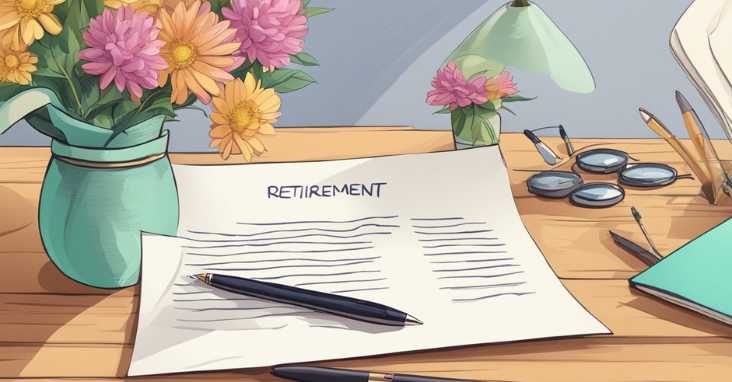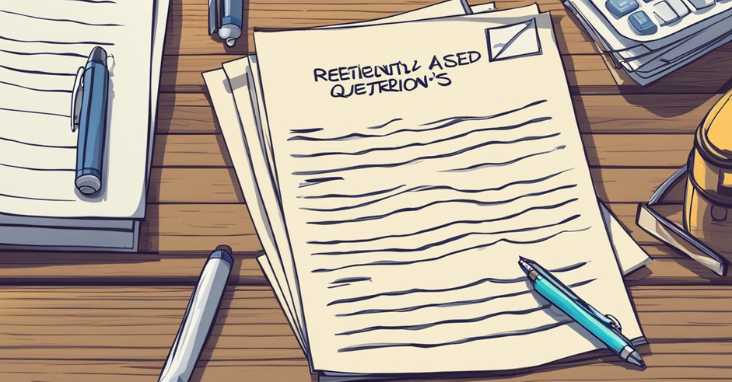How to write a retirement letter? Start with a formal greeting, state your retirement date, express gratitude, offer support for the transition, and close with warm wishes.
Retirement is a significant milestone in a person’s life and often marks the end of a long and successful career. One of the essential components of retiring is writing a retirement letter. A retirement letter is an official notification that informs an employer of an employee’s intention to retire. It is a crucial document that helps to ensure a smooth transition for both the employee and the employer.

Understanding Retirement Letters
Before writing a retirement letter, it is essential to understand what it is and why it is necessary. A retirement letter is a formal document that notifies an employer of an employee’s intention to retire. It is an important communication that helps to ensure a smooth and seamless transition for both parties. Writing a retirement letter can be a daunting task, but with the right guidance, it can be a straightforward and stress-free process.
Preparing to Write Your Retirement Letter
Writing a retirement letter requires careful planning and preparation. It is essential to consider several factors, such as the date of retirement and the components of a retirement letter. Taking the time to prepare adequately can help to ensure that the retirement letter is well-written, professional, and conveys the appropriate message.
Key Takeaways
- A retirement letter is an official notification that informs an employer of an employee’s intention to retire.
- Writing a retirement letter requires careful planning and preparation to ensure that it is well-written and conveys the appropriate message.
- Components of a retirement letter include conveying gratitude and respect, discussing transition and future plans, and finalizing the retirement letter.
Understanding Retirement Letters
Retirement letters are formal letters that an employee writes to inform their employer of their intention to retire from their job. Retirement letters are an important part of the communication process between the employee and employer, and they serve as a formal record of the employee’s retirement.
Purpose of a Retirement Letter
The purpose of a retirement letter is to inform the employer of the employee’s intention to retire. Retirement letters are important because they provide the employer with notice of the employee’s retirement, which can help the employer plan for the future. Retirement letters also serve as a formal record of the employee’s retirement, which can be used for legal and administrative purposes.
When writing a retirement letter, it is important to include the date of retirement, the reason for retirement, and any other relevant information. Retirement letters should be written in a professional tone and should be addressed to the appropriate person or department.
Retirement Letter vs Resignation Letter
Retirement letters are similar to resignation letters, but there are some key differences. Resignation letters are typically written when an employee is leaving their job voluntarily, while retirement letters are written when an employee is retiring. Retirement letters often include more information than resignation letters, such as the date of retirement and the reason for retirement.
It is important to note that retirement letters are not the same as retirement resignation letters. Retirement resignation letters are written when an employee is retiring but also resigning from their job. Retirement resignation letters should include both retirement and resignation information.
For more information on retirement letters, check out this article from The Balance Careers.
Preparing to Write Your Retirement Letter
Assessing Retirement Plans
Before writing a retirement letter, it is important to assess retirement plans and policies. Retirement policies are different for each organization, and it is essential to understand the policies and the benefits associated with them. One can consult the HR department or the company’s retirement plan administrator to get more information about the retirement plan.
It is also important to take into consideration the transition process. One should consider how the organization will transition the responsibilities and duties of the retiring employee to other employees. This will help in planning the retirement date and ensure a smooth transition.
Setting Your Retirement Date
After assessing retirement plans and policies, the next step is to set the retirement date. One should consider the retirement benefits and the financial implications of retiring on a particular date. Retirement calculators can help in determining the financial impact of retiring on a particular date.
It is also important to plan for the transition and ensure that the organization has enough time to transition the responsibilities and duties of the retiring employee. One should also consider personal factors such as health, family obligations, and personal interests when setting the retirement date.
When writing a retirement letter, it is important to clearly state the retirement date and ensure that it aligns with the organization’s policies. One should also express gratitude towards the organization and colleagues for their support and guidance throughout the career.
For more information on retirement planning, one can visit AARP.
Components of a Retirement Letter
Retirement is a significant milestone in a person’s life, and it is essential to inform the employer formally. A retirement letter is a professional way to communicate the decision to retire. The retirement letter should be well-written and convey gratitude, respect, and professional courtesy.
Header and Contact Information
The retirement letter should begin with the header and contact information. The header should include the employee’s name, address, phone number, and email address. The contact information should be followed by the date and the employer’s name and address.
Body of the Letter
The body of the letter should be concise and to the point. The employee should express gratitude for the opportunities provided by the employer and mention the positive experiences during the career. The letter should also include the date of retirement and a transition period if applicable. The employee should mention any outstanding projects and offer to assist in the transition process.
It is essential to maintain a professional tone throughout the letter. The employee should avoid negative comments or complaints and focus on the positive aspects of the career.
Conclusion and Signature
The conclusion should summarize the main points of the letter and express gratitude and respect for the employer. The employee should sign the letter and include their full name and contact information.
A retirement letter template can be helpful in drafting the letter. One example of a retirement letter template can be found on The Balance Careers website, which has high authority on the topic of retirement letters.
In conclusion, a well-written retirement letter is an essential component of the retirement process. The retirement letter should convey gratitude, respect, and professional courtesy and provide clear and concise information about the retirement date and transition period.
Conveying Gratitude and Respect

When writing a retirement letter, it is important to convey gratitude and respect to colleagues and mentors who have played a significant role in one’s career. This section will provide some tips on how to express thanks and acknowledge mentorship and support.
Expressing Thanks to Colleagues
Retiring from a job means leaving behind colleagues with whom one has formed close relationships over the years. It is important to express gratitude to these colleagues for their support and camaraderie. One way to do this is to write a personal note to each colleague, thanking them for their contributions to one’s career and wishing them well in their future endeavors.
Another way to express thanks to colleagues is to organize a retirement party or gathering. This can be a great opportunity to say goodbye to colleagues in person and to thank them for their support over the years. It is also a chance to share memories and stories from one’s time at the company.
Acknowledging Mentorship and Support
Retiring also means leaving behind mentors who have provided guidance and support throughout one’s career. It is important to acknowledge their contributions and express gratitude for their mentorship. One way to do this is to write a personal note to each mentor, thanking them for their guidance and support over the years.
Another way to acknowledge mentorship and support is to give a public speech or toast at a retirement party or gathering. This can be a great opportunity to thank mentors in front of colleagues and to share stories about their impact on one’s career.
It is important to remember that expressing gratitude and respect is not only a way to thank colleagues and mentors, but also a way to leave a positive impression and legacy at the company. By showing appreciation for those who have helped along the way, one can leave a lasting impression of professionalism and gratitude.
Here is a helpful resource for tips on writing a retirement letter.
Discussing Transition and Future Plans

Retiring from a job can be a major life transition, and it’s important to discuss future plans with your employer. This section will cover some key points to consider when discussing transition and future plans.
Planning for a Smooth Transition
One of the most important aspects of retirement is ensuring a smooth transition for both the employee and the employer. This may involve creating a transition plan that outlines the employee’s responsibilities leading up to retirement, as well as any training or support that may be needed for the employee’s replacement.
It’s also important to discuss the employee’s role during the transition period. Will they be available to answer questions or provide guidance to their replacement? Will they be involved in any ongoing projects or initiatives? These are all important considerations that should be addressed in the retirement letter.
Mentioning Post-Retirement Involvement
While retirement may mark the end of an employee’s full-time work with an organization, it doesn’t necessarily mean the end of their involvement. Many retirees go on to pursue consulting opportunities, part-time work, or other forms of involvement with their former employer.
If the employee is interested in pursuing such opportunities, it’s important to mention this in the retirement letter. This can help to open up opportunities for future collaboration and ensure a smooth transition into retirement.
Overall, discussing transition and future plans is an important part of the retirement process. By working closely with their employer and outlining their plans clearly in the retirement letter, employees can ensure a smooth and successful transition into retirement.
Here is a resource that provides 10 steps for getting ready for retirement.
Finalizing Your Retirement Letter

Once you have written your retirement letter, it is important to finalize it before submitting it to your employer. This section will cover two important aspects of finalizing your retirement letter: proofreading and professionalism, and submitting the letter via proper channels.
Proofreading and Professionalism
When finalizing your retirement letter, it is essential to proofread it carefully to ensure it is concise, clear, and error-free. A retirement notice that is well-written and free of errors will demonstrate your professionalism and attention to detail. It is also important to ensure that the tone of the letter is appropriate and respectful.
To ensure that your letter is professional and error-free, consider using a proofreading tool such as Grammarly. This tool can help you catch any spelling or grammar errors and ensure that your letter is clear and concise.
Submitting the Letter via Proper Channels
Once you have finalized your retirement letter, it is important to submit it via the proper channels. This means giving notice to your employer in a timely and formal manner. In most cases, this will involve submitting your retirement letter to your supervisor or HR department.
It is also important to consider whether you should submit your letter via email or in person. While email may be more convenient, submitting your letter in person can demonstrate your professionalism and commitment to your employer.
When submitting your retirement letter, be sure to follow any specific instructions provided by your employer. This may include providing a certain amount of notice or filling out specific forms.
To learn more about how to finalize your retirement letter and submit it via proper channels, consider reading this guide from The Balance Careers.
Frequently Asked Questions

What are the essential elements to include in a retirement letter?
When writing a retirement letter, it is important to include your intention to retire, the date of your retirement, and a brief explanation of your reason for retiring. Additionally, you may want to thank your employer and colleagues for their support throughout your career.
How can I express gratitude in my retirement letter?
To express gratitude in your retirement letter, you can thank your employer and colleagues for their support, guidance, and mentorship throughout your career. You can also mention specific examples of how they have helped you grow professionally.
What is the appropriate length for a retirement letter?
A retirement letter should be brief and to the point, typically no longer than one page. It should include all the essential elements mentioned above and express your gratitude in a concise manner.
How far in advance should I submit my retirement letter to my employer?
It is recommended to submit your retirement letter to your employer at least two weeks in advance. This gives your employer enough time to make necessary arrangements and find a replacement if needed.
What format should I follow when writing a retirement letter?
A retirement letter should follow a formal business letter format. This includes a header with your contact information, the date, a formal salutation, and a closing with your signature.
How do I address my retirement letter to my employer?
When addressing your retirement letter to your employer, use their formal title and last name, such as “Dear Mr. Smith” or “Dear Dr. Johnson.” If you are unsure of their formal title, you can check with HR or their assistant.
For more information on writing a retirement letter, you can refer to The Balance’s guide to writing a retirement letter.















